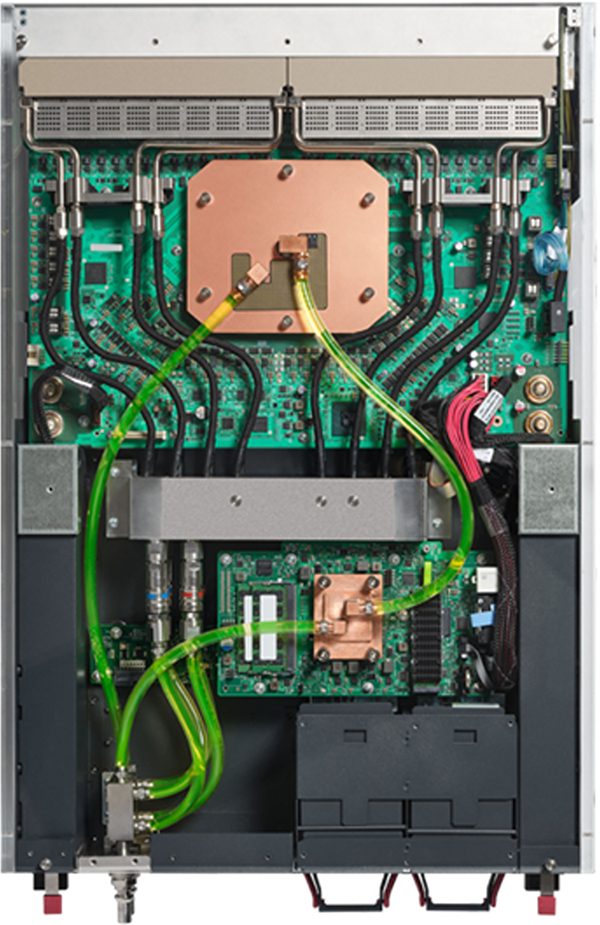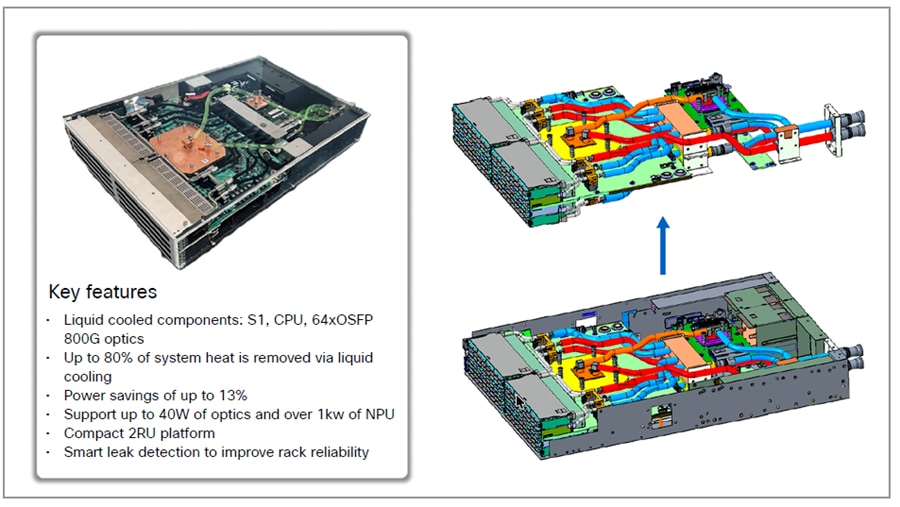Exploring the Future of AI Networking: Liquid-Cooled Switches on the Horizon Solution Overview
Available Languages
Bias-Free Language
The documentation set for this product strives to use bias-free language. For the purposes of this documentation set, bias-free is defined as language that does not imply discrimination based on age, disability, gender, racial identity, ethnic identity, sexual orientation, socioeconomic status, and intersectionality. Exceptions may be present in the documentation due to language that is hardcoded in the user interfaces of the product software, language used based on RFP documentation, or language that is used by a referenced third-party product. Learn more about how Cisco is using Inclusive Language.
Imagine a data center where even the most powerful switches run cool and stable— without noise, thermal throttling, or energy waste. Cisco is actively innovating in direct-to-chip liquid cooling for high-performance switches, laying the groundwork for solutions that will enable seamless and scalable AI at unprecedented densities.
Today’s rack switches are rapidly approaching their thermal limits with the jump to 400G, 800G, and beyond. The consequences can be bottlenecks, throttling, and increased operating costs. Direct-to-chip liquid cooling—currently in development—will fundamentally change what’s possible. By extracting heat directly from ASICs and high-power components, it will unlock new levels of performance and efficiency.
Cisco is leading this innovation with ongoing R&D into direct-to-chip liquid-cooled switching platforms. By connecting you to this technology path before launch, we invite you to assess, plan, and pave the way for easy adoption when these solutions become available.


Cisco liquid-cooled 51.2T switch
● Be ready for unleashed performance: Enable a future where switches maintain top throughput with zero thermal compromise— even as bandwidth and port densities push higher.
● Plan for greener operations: Direct-to-chip cooling is designed to offset the rising power needed for next-generation switches, with the goal of up to 30% to 50%1 energy savings over air cooling in anticipated deployments.
● Design for density: Learn how these innovations could allow denser fabrics, empowering larger, faster AI clusters within your existing footprint.
● Increase reliability: Targeted liquid cooling promises reduced component stress, extended switch lifespan, and improved network uptime.
● Proactively manage risk: Advanced leak detection, corrosion prevention technologies, and comprehensive monitoring capabilities are being engineered directly into liquid-cooled switch designs to help safeguard your infrastructure, maximize uptime, and provide operational peace of mind.
● Stay up to date on seamless integration on the horizon: Early awareness empowers you to architect data halls, racks, and management systems that are ready to accommodate liquid-cooled networks with minimal disruption when the time comes.
Preparing for a cool revolution in network infrastructure
AI and data center trends point toward massive, multi-terabit fabrics with thermal outputs beyond today’s air-cooled designs. Challenges for future solutions include:
● Thermal saturation: Anticipated switch ASIC power levels will require more direct, efficient heat removal than fans or airflow can deliver.
● Rising energy costs: As processing demands increase, air-cooled systems require more energy to manage the additional heat. This underscores the urgent need to improve Power Usage Effectiveness (PUE) and overall cooling efficiency.
● Deployment roadblocks: Early planning can prevent costly retrofits and integration headaches once liquid-cooled switches debut.
● Operational resiliency: Projects in development aim to include advanced telemetry, monitoring, and self-protection for long-term reliability.
Act now to assess your readiness, understand design considerations, and advocate for data center layouts compatible with liquid cooling.
While direct-to-chip liquid-cooled switches are not yet commercially available, our vision for the technology includes:
● Liquid cold plates for ASICs: Innovative cold plate designs will mount directly to switch ASICs, featuring quality connectors with leak detection. System reliability will be enhanced through component redundancy, such as redundant pumps or Cooling Distribution Units (CDUs), rather than by hot-swapping individual liquid components.
● Next-generation Cisco Nexus® hardware: Preparing for 800G+ switch platforms engineered from the ground up for integration with liquid cooling infrastructure.
● Modular cooling manifolds: Quick-connect plumbing for easy serviceability and safe operation.
● Full infrastructure compatibility: Anticipated integration with CDUs, rear-door heat exchangers, and smart controls for data center-wide efficiency.
● Cluster-ready delivery: Designed for seamless rack- or cluster-level integration, either in Cisco® validated systems or as standalone network blocks, when available.
Table 1. Use cases
| Use case |
Future impact |
| AI/ML cluster networks |
High-radix, liquid-cooled fabrics are poised to interconnect future GPU and accelerator clusters at massive scale, unbound by heat limits. |
| High-density data halls |
Facility designs that anticipate and accommodate liquid-cooled switches can maximize capacity and minimize cooling overhead. |
| Sustainable data centers |
Early planning for liquid-cooled network gear positions organizations for aggressive energy efficiency and green IT targets. |
| Remote/modular edge deployments |
Liquid-cooled switching may soon enable powerful AI processing in edge and containerized environments where airflow and climate controls are constrained. |
Preparing for direct-to-chip liquid-cooled switches today is the first step toward tomorrow’s resilient, sustainable AI networks.
By the time liquid-cooled switches reach commercial availability, facilities that have anticipated the shift will be ready to realize benefits immediately—energy savings, higher port densities, and increased uptime. Engaging now means your team and infrastructure stay ahead of cooling, energy, and networking bottlenecks.
“Cisco’s next-generation cooling innovations are designed for the future—start assessing your readiness for direct-to-chip liquid-cooled switches now to accelerate your AI roadmap when solutions arrive.”
Cisco is leading research and development in direct-to-chip liquid-cooled switching, building on a heritage of leadership in high-speed networking and integrated infrastructure. By fostering market awareness early, we partner with you to envision, plan, and prepare for next-level efficiency, density, and sustainability in the AI era.
Financing to help you achieve your objectives
Cisco Capital® can help you acquire the technology you need to achieve your objectives and stay competitive. We can help you reduce CapEx. Accelerate your growth. Optimize your investment dollars and ROI. Cisco Capital financing gives you flexibility in acquiring hardware, software, services, and complementary third-party equipment. And there’s just one predictable payment. Cisco Capital is available in more than 100 countries. Learn more.
Begin your liquid-cooled journey
Take steps now to modernize your facility and thermal management strategies for tomorrow’s liquid-cooled switches. Meet with your Cisco team or partner to discuss how to design, assess, and future-proof your data center for direct-to-chip cooling and advanced network performance.